Assessment Cover Sheet
VerifiedAdded on 2023/02/01
|14
|2820
|86
AI Summary
This form is to be completed by the assessor and used as a final record of student competency. All student submissions including any associated checklists are to be attached to this cover sheet before placing on the student's file.
Contribute Materials
Your contribution can guide someone’s learning journey. Share your
documents today.
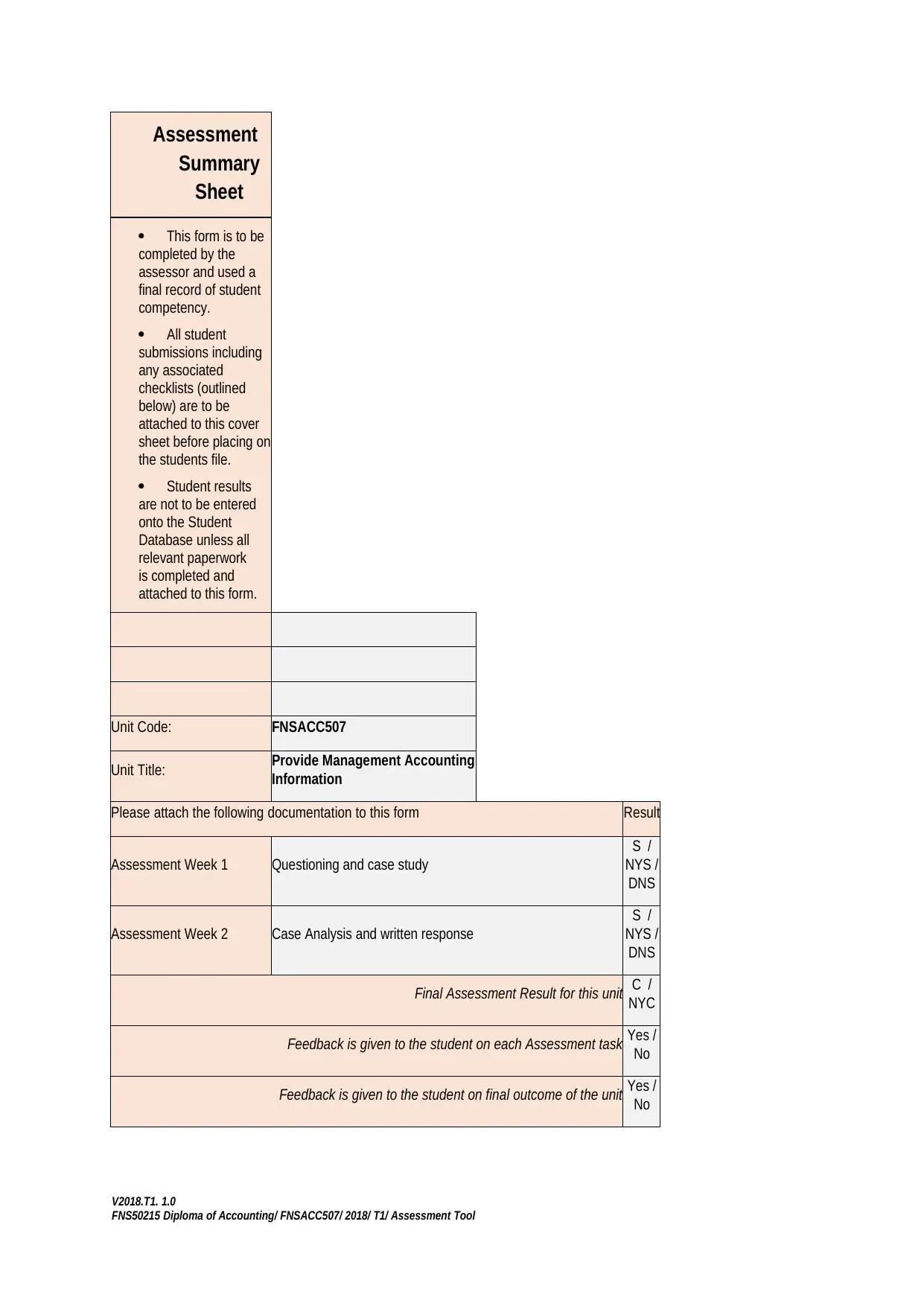
Assessment
Summary
Sheet
This form is to be
completed by the
assessor and used a
final record of student
competency.
All student
submissions including
any associated
checklists (outlined
below) are to be
attached to this cover
sheet before placing on
the students file.
Student results
are not to be entered
onto the Student
Database unless all
relevant paperwork
is completed and
attached to this form.
Unit Code: FNSACC507
Unit Title: Provide Management Accounting
Information
Please attach the following documentation to this form Result
Assessment Week 1 Questioning and case study
S /
NYS /
DNS
Assessment Week 2 Case Analysis and written response
S /
NYS /
DNS
Final Assessment Result for this unit C /
NYC
Feedback is given to the student on each Assessment task Yes /
No
Feedback is given to the student on final outcome of the unit Yes /
No
V2018.T1. 1.0
FNS50215 Diploma of Accounting/ FNSACC507/ 2018/ T1/ Assessment Tool
Summary
Sheet
This form is to be
completed by the
assessor and used a
final record of student
competency.
All student
submissions including
any associated
checklists (outlined
below) are to be
attached to this cover
sheet before placing on
the students file.
Student results
are not to be entered
onto the Student
Database unless all
relevant paperwork
is completed and
attached to this form.
Unit Code: FNSACC507
Unit Title: Provide Management Accounting
Information
Please attach the following documentation to this form Result
Assessment Week 1 Questioning and case study
S /
NYS /
DNS
Assessment Week 2 Case Analysis and written response
S /
NYS /
DNS
Final Assessment Result for this unit C /
NYC
Feedback is given to the student on each Assessment task Yes /
No
Feedback is given to the student on final outcome of the unit Yes /
No
V2018.T1. 1.0
FNS50215 Diploma of Accounting/ FNSACC507/ 2018/ T1/ Assessment Tool
Secure Best Marks with AI Grader
Need help grading? Try our AI Grader for instant feedback on your assignments.
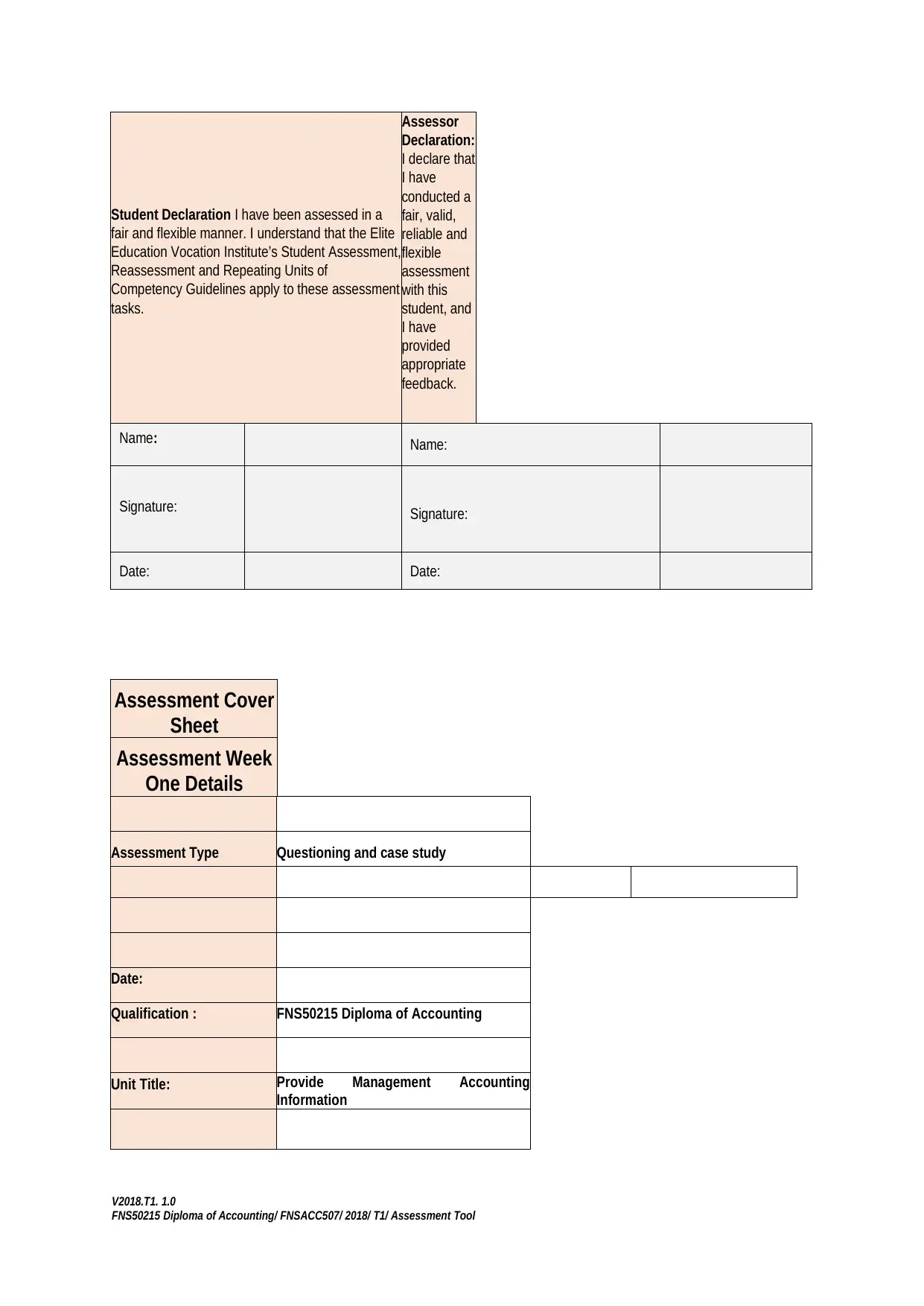
Student Declaration I have been assessed in a
fair and flexible manner. I understand that the Elite
Education Vocation Institute’s Student Assessment,
Reassessment and Repeating Units of
Competency Guidelines apply to these assessment
tasks.
Assessor
Declaration:
I declare that
I have
conducted a
fair, valid,
reliable and
flexible
assessment
with this
student, and
I have
provided
appropriate
feedback.
Name: Name:
Signature: Signature:
Date: Date:
Assessment Cover
Sheet
Assessment Week
One Details
Assessment Type Questioning and case study
Date:
Qualification : FNS50215 Diploma of Accounting
Unit Title: Provide Management Accounting
Information
V2018.T1. 1.0
FNS50215 Diploma of Accounting/ FNSACC507/ 2018/ T1/ Assessment Tool
fair and flexible manner. I understand that the Elite
Education Vocation Institute’s Student Assessment,
Reassessment and Repeating Units of
Competency Guidelines apply to these assessment
tasks.
Assessor
Declaration:
I declare that
I have
conducted a
fair, valid,
reliable and
flexible
assessment
with this
student, and
I have
provided
appropriate
feedback.
Name: Name:
Signature: Signature:
Date: Date:
Assessment Cover
Sheet
Assessment Week
One Details
Assessment Type Questioning and case study
Date:
Qualification : FNS50215 Diploma of Accounting
Unit Title: Provide Management Accounting
Information
V2018.T1. 1.0
FNS50215 Diploma of Accounting/ FNSACC507/ 2018/ T1/ Assessment Tool
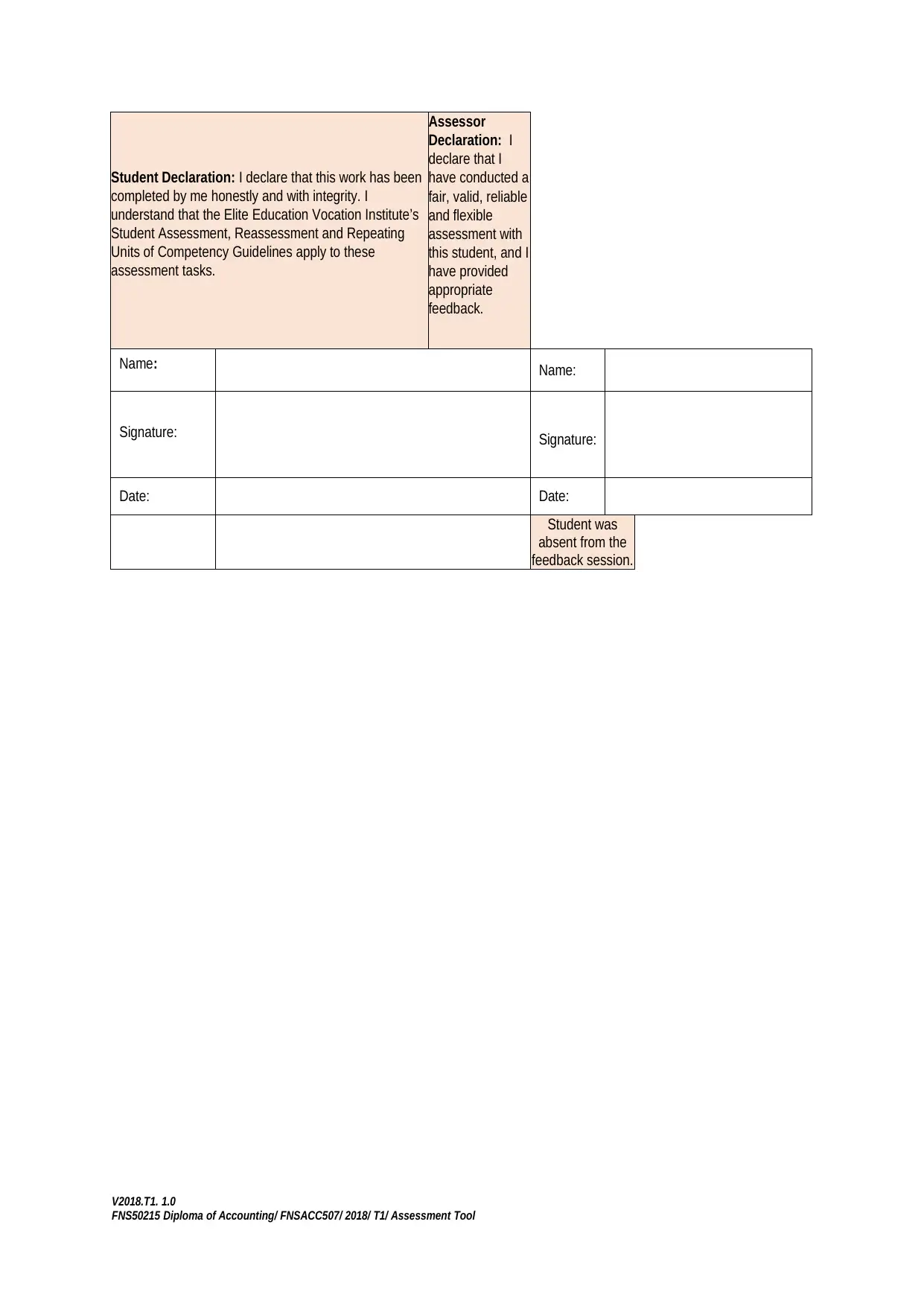
Student Declaration: I declare that this work has been
completed by me honestly and with integrity. I
understand that the Elite Education Vocation Institute’s
Student Assessment, Reassessment and Repeating
Units of Competency Guidelines apply to these
assessment tasks.
Assessor
Declaration: I
declare that I
have conducted a
fair, valid, reliable
and flexible
assessment with
this student, and I
have provided
appropriate
feedback.
Name: Name:
Signature: Signature:
Date: Date:
Student was
absent from the
feedback session.
V2018.T1. 1.0
FNS50215 Diploma of Accounting/ FNSACC507/ 2018/ T1/ Assessment Tool
completed by me honestly and with integrity. I
understand that the Elite Education Vocation Institute’s
Student Assessment, Reassessment and Repeating
Units of Competency Guidelines apply to these
assessment tasks.
Assessor
Declaration: I
declare that I
have conducted a
fair, valid, reliable
and flexible
assessment with
this student, and I
have provided
appropriate
feedback.
Name: Name:
Signature: Signature:
Date: Date:
Student was
absent from the
feedback session.
V2018.T1. 1.0
FNS50215 Diploma of Accounting/ FNSACC507/ 2018/ T1/ Assessment Tool
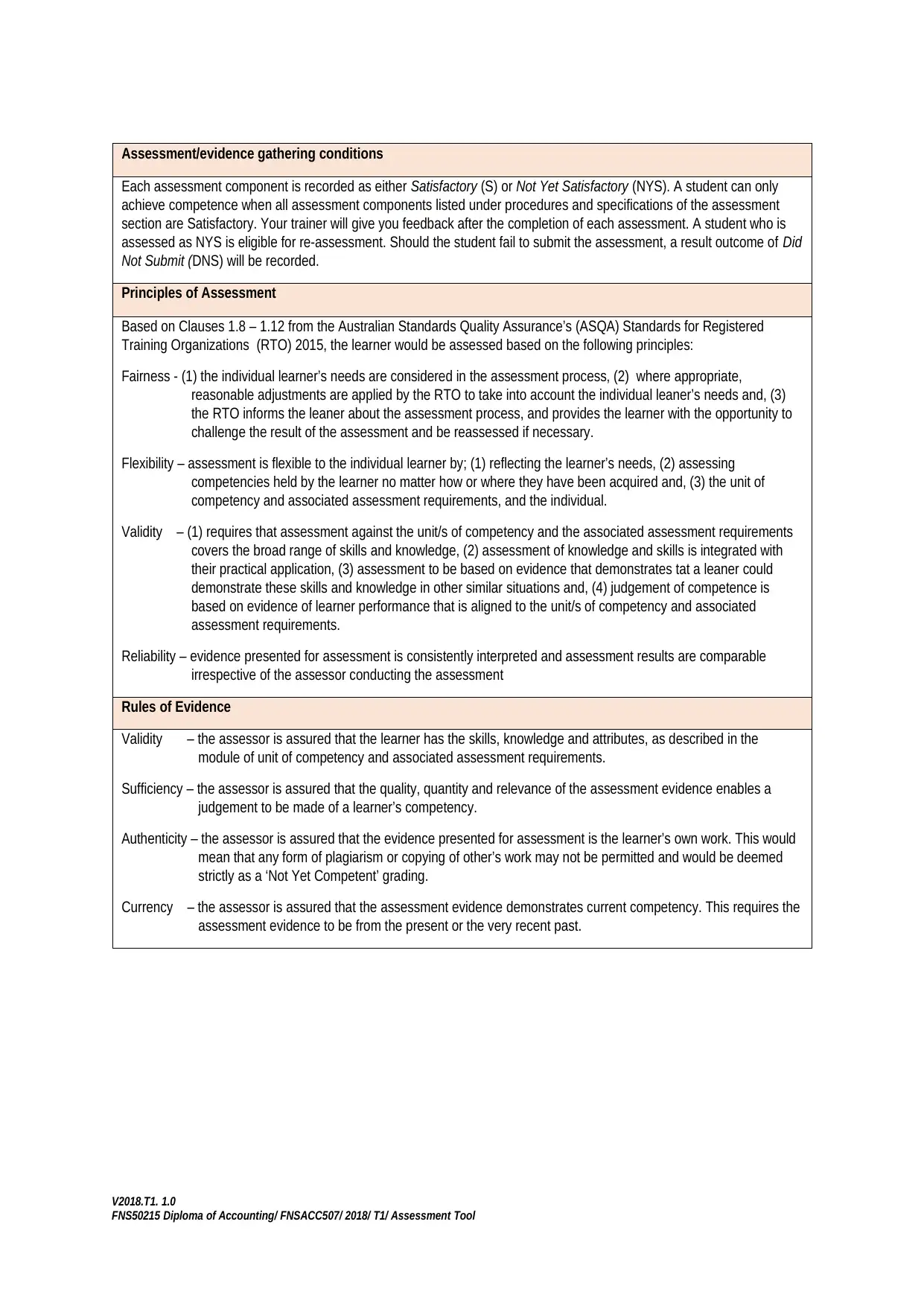
Assessment/evidence gathering conditions
Each assessment component is recorded as either Satisfactory (S) or Not Yet Satisfactory (NYS). A student can only
achieve competence when all assessment components listed under procedures and specifications of the assessment
section are Satisfactory. Your trainer will give you feedback after the completion of each assessment. A student who is
assessed as NYS is eligible for re-assessment. Should the student fail to submit the assessment, a result outcome of Did
Not Submit (DNS) will be recorded.
Principles of Assessment
Based on Clauses 1.8 – 1.12 from the Australian Standards Quality Assurance’s (ASQA) Standards for Registered
Training Organizations (RTO) 2015, the learner would be assessed based on the following principles:
Fairness - (1) the individual learner’s needs are considered in the assessment process, (2) where appropriate,
reasonable adjustments are applied by the RTO to take into account the individual leaner’s needs and, (3)
the RTO informs the leaner about the assessment process, and provides the learner with the opportunity to
challenge the result of the assessment and be reassessed if necessary.
Flexibility – assessment is flexible to the individual learner by; (1) reflecting the learner’s needs, (2) assessing
competencies held by the learner no matter how or where they have been acquired and, (3) the unit of
competency and associated assessment requirements, and the individual.
Validity – (1) requires that assessment against the unit/s of competency and the associated assessment requirements
covers the broad range of skills and knowledge, (2) assessment of knowledge and skills is integrated with
their practical application, (3) assessment to be based on evidence that demonstrates tat a leaner could
demonstrate these skills and knowledge in other similar situations and, (4) judgement of competence is
based on evidence of learner performance that is aligned to the unit/s of competency and associated
assessment requirements.
Reliability – evidence presented for assessment is consistently interpreted and assessment results are comparable
irrespective of the assessor conducting the assessment
Rules of Evidence
Validity – the assessor is assured that the learner has the skills, knowledge and attributes, as described in the
module of unit of competency and associated assessment requirements.
Sufficiency – the assessor is assured that the quality, quantity and relevance of the assessment evidence enables a
judgement to be made of a learner’s competency.
Authenticity – the assessor is assured that the evidence presented for assessment is the learner’s own work. This would
mean that any form of plagiarism or copying of other’s work may not be permitted and would be deemed
strictly as a ‘Not Yet Competent’ grading.
Currency – the assessor is assured that the assessment evidence demonstrates current competency. This requires the
assessment evidence to be from the present or the very recent past.
V2018.T1. 1.0
FNS50215 Diploma of Accounting/ FNSACC507/ 2018/ T1/ Assessment Tool
Each assessment component is recorded as either Satisfactory (S) or Not Yet Satisfactory (NYS). A student can only
achieve competence when all assessment components listed under procedures and specifications of the assessment
section are Satisfactory. Your trainer will give you feedback after the completion of each assessment. A student who is
assessed as NYS is eligible for re-assessment. Should the student fail to submit the assessment, a result outcome of Did
Not Submit (DNS) will be recorded.
Principles of Assessment
Based on Clauses 1.8 – 1.12 from the Australian Standards Quality Assurance’s (ASQA) Standards for Registered
Training Organizations (RTO) 2015, the learner would be assessed based on the following principles:
Fairness - (1) the individual learner’s needs are considered in the assessment process, (2) where appropriate,
reasonable adjustments are applied by the RTO to take into account the individual leaner’s needs and, (3)
the RTO informs the leaner about the assessment process, and provides the learner with the opportunity to
challenge the result of the assessment and be reassessed if necessary.
Flexibility – assessment is flexible to the individual learner by; (1) reflecting the learner’s needs, (2) assessing
competencies held by the learner no matter how or where they have been acquired and, (3) the unit of
competency and associated assessment requirements, and the individual.
Validity – (1) requires that assessment against the unit/s of competency and the associated assessment requirements
covers the broad range of skills and knowledge, (2) assessment of knowledge and skills is integrated with
their practical application, (3) assessment to be based on evidence that demonstrates tat a leaner could
demonstrate these skills and knowledge in other similar situations and, (4) judgement of competence is
based on evidence of learner performance that is aligned to the unit/s of competency and associated
assessment requirements.
Reliability – evidence presented for assessment is consistently interpreted and assessment results are comparable
irrespective of the assessor conducting the assessment
Rules of Evidence
Validity – the assessor is assured that the learner has the skills, knowledge and attributes, as described in the
module of unit of competency and associated assessment requirements.
Sufficiency – the assessor is assured that the quality, quantity and relevance of the assessment evidence enables a
judgement to be made of a learner’s competency.
Authenticity – the assessor is assured that the evidence presented for assessment is the learner’s own work. This would
mean that any form of plagiarism or copying of other’s work may not be permitted and would be deemed
strictly as a ‘Not Yet Competent’ grading.
Currency – the assessor is assured that the assessment evidence demonstrates current competency. This requires the
assessment evidence to be from the present or the very recent past.
V2018.T1. 1.0
FNS50215 Diploma of Accounting/ FNSACC507/ 2018/ T1/ Assessment Tool
Secure Best Marks with AI Grader
Need help grading? Try our AI Grader for instant feedback on your assignments.
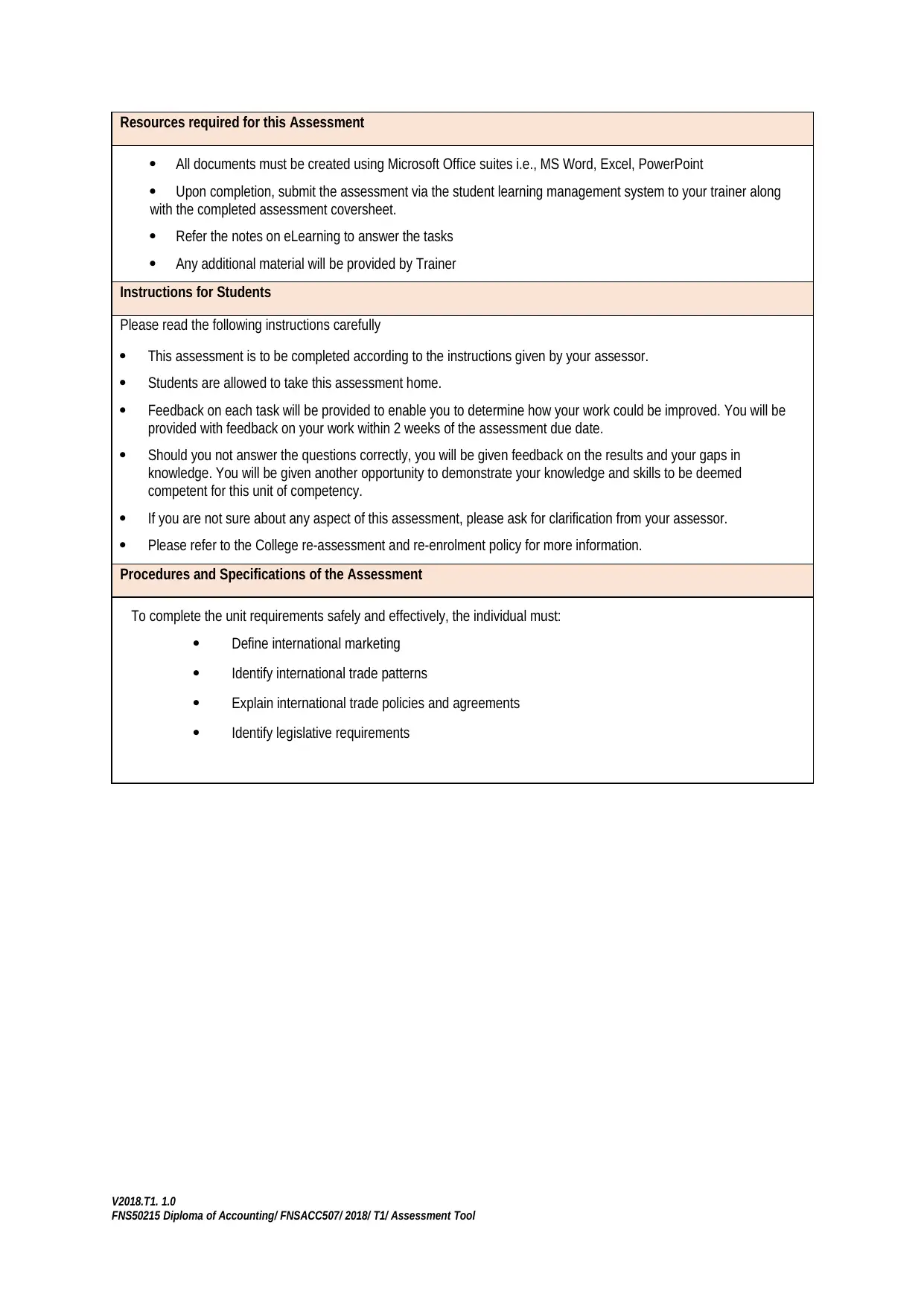
Resources required for this Assessment
All documents must be created using Microsoft Office suites i.e., MS Word, Excel, PowerPoint
Upon completion, submit the assessment via the student learning management system to your trainer along
with the completed assessment coversheet.
Refer the notes on eLearning to answer the tasks
Any additional material will be provided by Trainer
Instructions for Students
Please read the following instructions carefully
This assessment is to be completed according to the instructions given by your assessor.
Students are allowed to take this assessment home.
Feedback on each task will be provided to enable you to determine how your work could be improved. You will be
provided with feedback on your work within 2 weeks of the assessment due date.
Should you not answer the questions correctly, you will be given feedback on the results and your gaps in
knowledge. You will be given another opportunity to demonstrate your knowledge and skills to be deemed
competent for this unit of competency.
If you are not sure about any aspect of this assessment, please ask for clarification from your assessor.
Please refer to the College re-assessment and re-enrolment policy for more information.
Procedures and Specifications of the Assessment
To complete the unit requirements safely and effectively, the individual must:
Define international marketing
Identify international trade patterns
Explain international trade policies and agreements
Identify legislative requirements
V2018.T1. 1.0
FNS50215 Diploma of Accounting/ FNSACC507/ 2018/ T1/ Assessment Tool
All documents must be created using Microsoft Office suites i.e., MS Word, Excel, PowerPoint
Upon completion, submit the assessment via the student learning management system to your trainer along
with the completed assessment coversheet.
Refer the notes on eLearning to answer the tasks
Any additional material will be provided by Trainer
Instructions for Students
Please read the following instructions carefully
This assessment is to be completed according to the instructions given by your assessor.
Students are allowed to take this assessment home.
Feedback on each task will be provided to enable you to determine how your work could be improved. You will be
provided with feedback on your work within 2 weeks of the assessment due date.
Should you not answer the questions correctly, you will be given feedback on the results and your gaps in
knowledge. You will be given another opportunity to demonstrate your knowledge and skills to be deemed
competent for this unit of competency.
If you are not sure about any aspect of this assessment, please ask for clarification from your assessor.
Please refer to the College re-assessment and re-enrolment policy for more information.
Procedures and Specifications of the Assessment
To complete the unit requirements safely and effectively, the individual must:
Define international marketing
Identify international trade patterns
Explain international trade policies and agreements
Identify legislative requirements
V2018.T1. 1.0
FNS50215 Diploma of Accounting/ FNSACC507/ 2018/ T1/ Assessment Tool

Assessment 1
(Process financial transactions and interim report)
Part 1 - Multiple Choice ( Circle the one best answer)
1. Which one of the following would be considered a user of management
accounting information?
A. Stockholders B. Controller C. Creditors D. Suppliers
2. Which of the following would NOT be a characteristic of managerial
accounting?
A. It is designed to influence the behaviour of managers.
B. It is future oriented.
C. It must follow GAAP just like financial accounting.
D. It varies from hourly reports to reports that may span 20 years.
3. The term used to describe the assignment of direct costs to the particular
cost object is
A. cost allocation. B. cost tracing. C. cost accumulation. D. cost assignment.
4. The term used to describe the assignment of indirect costs to a particular
cost object would be
A. cost allocation B. cost tracing C. cost accumulation D. cost assignment.
5. As the quantity produced increases, fixed costs per unit are expected to
A. increase per unit.
B. decrease per unit.
C. stay the same per unit.
D. None of the above.
6. The cost of materials that have been started into production, but are not
completely processed, would be found in which inventory account on the
balance sheet?
A. Direct materials inventory.
B. Work-in-process inventory.
C. Supplies inventory.
D. Finished goods inventory.
7. Costs at a service sector company are normally considered
A. inventoriable costs.
B. period costs.
V2018.T1. 1.0
FNS50215 Diploma of Accounting/ FNSACC507/ 2018/ T1/ Assessment Tool
(Process financial transactions and interim report)
Part 1 - Multiple Choice ( Circle the one best answer)
1. Which one of the following would be considered a user of management
accounting information?
A. Stockholders B. Controller C. Creditors D. Suppliers
2. Which of the following would NOT be a characteristic of managerial
accounting?
A. It is designed to influence the behaviour of managers.
B. It is future oriented.
C. It must follow GAAP just like financial accounting.
D. It varies from hourly reports to reports that may span 20 years.
3. The term used to describe the assignment of direct costs to the particular
cost object is
A. cost allocation. B. cost tracing. C. cost accumulation. D. cost assignment.
4. The term used to describe the assignment of indirect costs to a particular
cost object would be
A. cost allocation B. cost tracing C. cost accumulation D. cost assignment.
5. As the quantity produced increases, fixed costs per unit are expected to
A. increase per unit.
B. decrease per unit.
C. stay the same per unit.
D. None of the above.
6. The cost of materials that have been started into production, but are not
completely processed, would be found in which inventory account on the
balance sheet?
A. Direct materials inventory.
B. Work-in-process inventory.
C. Supplies inventory.
D. Finished goods inventory.
7. Costs at a service sector company are normally considered
A. inventoriable costs.
B. period costs.
V2018.T1. 1.0
FNS50215 Diploma of Accounting/ FNSACC507/ 2018/ T1/ Assessment Tool

C. prime costs.
D. None of the above.
8. Which of the following is NOT a feature of cost accounting and cost
management?
A. Calculating the cost of cost objects.
B. Obtaining information for planning, control and performance evaluation.
C. Analyzing relevant information for making decisions.
D. Allocating period costs to specific products.
9. As activity changes, a cost that is variable will
A. vary per unit.
B. remain the same per unit.
C. vary inversely with activity per unit.
D. remain the same in total amount.
10. Ford Automotive Company is considered an example of a
A. merchandiser.
B. service company.
C. manufacturer.
D. wholesaler.
Part 2 Answer all questions below
Question: 1.
Zebra Productions presents you with the following data for the month of March 2014.
$
Purchases 42 300
Direct labor cost 10 000
Cost of goods sold 61 000
Manufacturing overheads 15 000
Inventory accounts showed the following opening and closing balances:
1stMarch
$
31st March
$
V2018.T1. 1.0
FNS50215 Diploma of Accounting/ FNSACC507/ 2018/ T1/ Assessment Tool
D. None of the above.
8. Which of the following is NOT a feature of cost accounting and cost
management?
A. Calculating the cost of cost objects.
B. Obtaining information for planning, control and performance evaluation.
C. Analyzing relevant information for making decisions.
D. Allocating period costs to specific products.
9. As activity changes, a cost that is variable will
A. vary per unit.
B. remain the same per unit.
C. vary inversely with activity per unit.
D. remain the same in total amount.
10. Ford Automotive Company is considered an example of a
A. merchandiser.
B. service company.
C. manufacturer.
D. wholesaler.
Part 2 Answer all questions below
Question: 1.
Zebra Productions presents you with the following data for the month of March 2014.
$
Purchases 42 300
Direct labor cost 10 000
Cost of goods sold 61 000
Manufacturing overheads 15 000
Inventory accounts showed the following opening and closing balances:
1stMarch
$
31st March
$
V2018.T1. 1.0
FNS50215 Diploma of Accounting/ FNSACC507/ 2018/ T1/ Assessment Tool
Paraphrase This Document
Need a fresh take? Get an instant paraphrase of this document with our AI Paraphraser

Direct materials 7,000 7,400
Work-in-procss 9,600 13,000
Finished goods 15,000 17,500
Other expenses for the month were:
Selling expenses $4,100
General and administrative expenses $2,900
Sales for the month were $82,000
Required: 8marks
a) Prepare Manufacturing Statement for the month ending 31st March
b) Trading Account for the month.
c) Profit & Loss Statement for the same month.
a) Manufacturing statement:
Zebra Production’s Manufacturing
Statement for month ended 31st March 2014
$ $
Raw materials inventory 7000
Purchases 42300
Total materials available 49300
Less: Raw Materials Inventory -7400
Cost of raw materials consumed 41900
Cost of direct labor 10000
Cost of manufacturing overhead 15000
Total Cost charged into production 66900
Add: Work-in-Process Inventory 9600
76500
Less: Work-in-Process Inventory -13000
Cost of goods manufactured 63500
b) Trading statement:
Zebra Productions Trading Statement for
month ended 31st March 2014
$ $
Sales 82000
V2018.T1. 1.0
FNS50215 Diploma of Accounting/ FNSACC507/ 2018/ T1/ Assessment Tool
Work-in-procss 9,600 13,000
Finished goods 15,000 17,500
Other expenses for the month were:
Selling expenses $4,100
General and administrative expenses $2,900
Sales for the month were $82,000
Required: 8marks
a) Prepare Manufacturing Statement for the month ending 31st March
b) Trading Account for the month.
c) Profit & Loss Statement for the same month.
a) Manufacturing statement:
Zebra Production’s Manufacturing
Statement for month ended 31st March 2014
$ $
Raw materials inventory 7000
Purchases 42300
Total materials available 49300
Less: Raw Materials Inventory -7400
Cost of raw materials consumed 41900
Cost of direct labor 10000
Cost of manufacturing overhead 15000
Total Cost charged into production 66900
Add: Work-in-Process Inventory 9600
76500
Less: Work-in-Process Inventory -13000
Cost of goods manufactured 63500
b) Trading statement:
Zebra Productions Trading Statement for
month ended 31st March 2014
$ $
Sales 82000
V2018.T1. 1.0
FNS50215 Diploma of Accounting/ FNSACC507/ 2018/ T1/ Assessment Tool
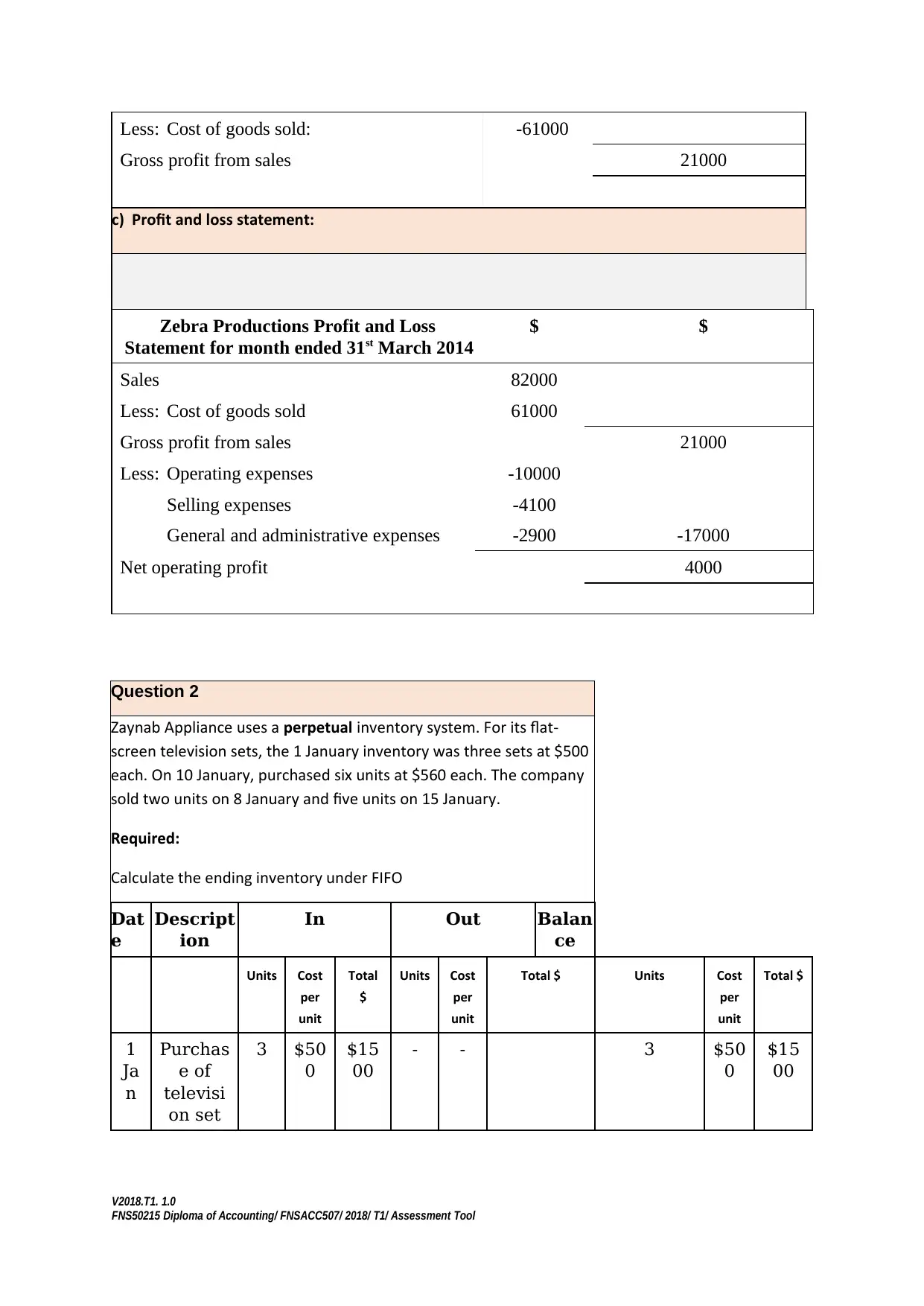
Less: Cost of goods sold: -61000
Gross profit from sales 21000
c) Profit and loss statement:
Zebra Productions Profit and Loss
Statement for month ended 31st March 2014
$ $
Sales 82000
Less: Cost of goods sold 61000
Gross profit from sales 21000
Less: Operating expenses -10000
Selling expenses -4100
General and administrative expenses -2900 -17000
Net operating profit 4000
Question 2
Zaynab Appliance uses a perpetual inventory system. For its flat-
screen television sets, the 1 January inventory was three sets at $500
each. On 10 January, purchased six units at $560 each. The company
sold two units on 8 January and five units on 15 January.
Required:
Calculate the ending inventory under FIFO
Dat
e
Descript
ion
In Out Balan
ce
Units Cost
per
unit
Total
$
Units Cost
per
unit
Total $ Units Cost
per
unit
Total $
1
Ja
n
Purchas
e of
televisi
on set
3 $50
0
$15
00
- - 3 $50
0
$15
00
V2018.T1. 1.0
FNS50215 Diploma of Accounting/ FNSACC507/ 2018/ T1/ Assessment Tool
Gross profit from sales 21000
c) Profit and loss statement:
Zebra Productions Profit and Loss
Statement for month ended 31st March 2014
$ $
Sales 82000
Less: Cost of goods sold 61000
Gross profit from sales 21000
Less: Operating expenses -10000
Selling expenses -4100
General and administrative expenses -2900 -17000
Net operating profit 4000
Question 2
Zaynab Appliance uses a perpetual inventory system. For its flat-
screen television sets, the 1 January inventory was three sets at $500
each. On 10 January, purchased six units at $560 each. The company
sold two units on 8 January and five units on 15 January.
Required:
Calculate the ending inventory under FIFO
Dat
e
Descript
ion
In Out Balan
ce
Units Cost
per
unit
Total
$
Units Cost
per
unit
Total $ Units Cost
per
unit
Total $
1
Ja
n
Purchas
e of
televisi
on set
3 $50
0
$15
00
- - 3 $50
0
$15
00
V2018.T1. 1.0
FNS50215 Diploma of Accounting/ FNSACC507/ 2018/ T1/ Assessment Tool
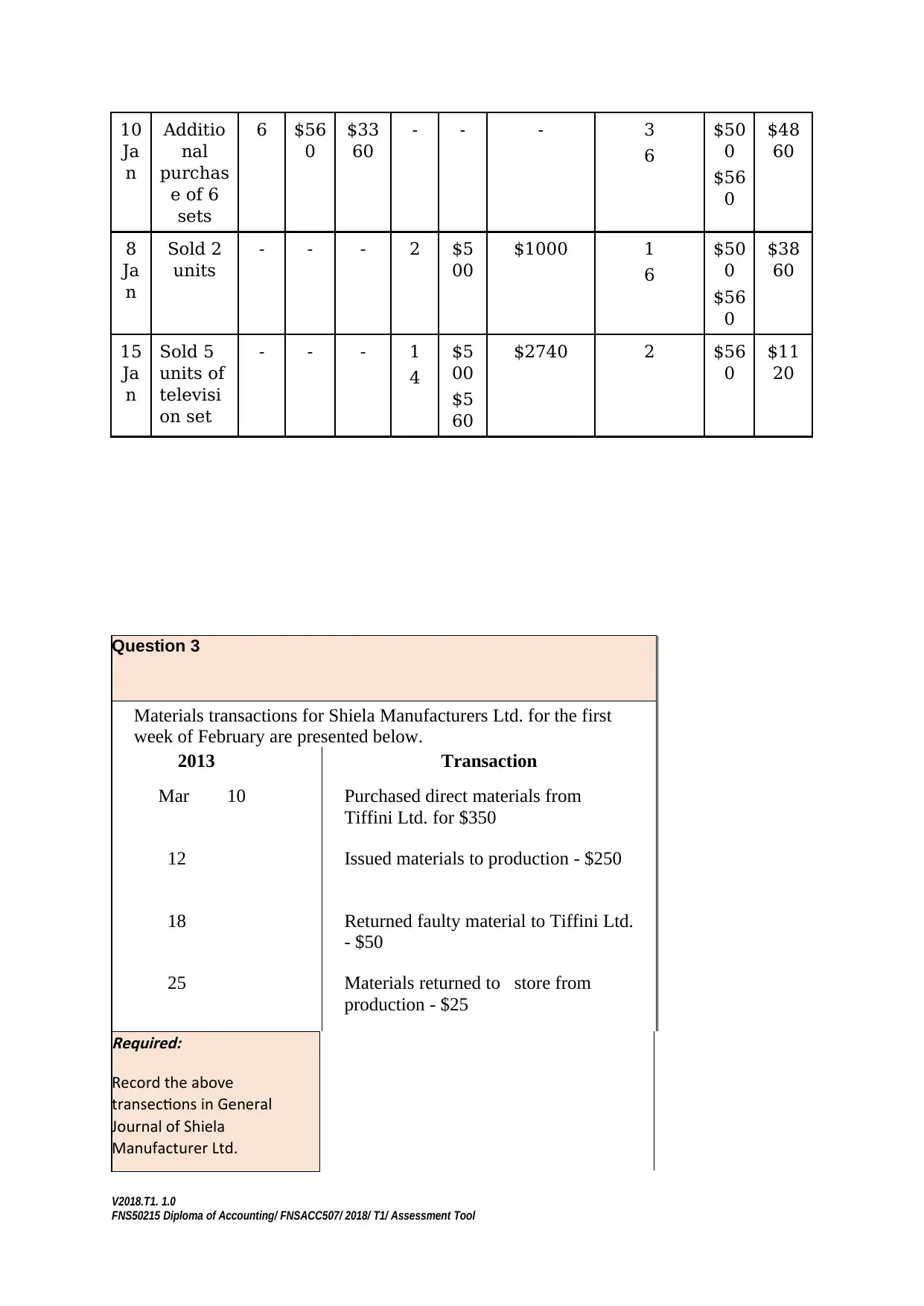
10
Ja
n
Additio
nal
purchas
e of 6
sets
6 $56
0
$33
60
- - - 3
6
$50
0
$56
0
$48
60
8
Ja
n
Sold 2
units
- - - 2 $5
00
$1000 1
6
$50
0
$56
0
$38
60
15
Ja
n
Sold 5
units of
televisi
on set
- - - 1
4
$5
00
$5
60
$2740 2 $56
0
$11
20
Question 3
Materials transactions for Shiela Manufacturers Ltd. for the first
week of February are presented below.
2013 Transaction
Mar 10 Purchased direct materials from
Tiffini Ltd. for $350
12 Issued materials to production - $250
18 Returned faulty material to Tiffini Ltd.
- $50
25 Materials returned to store from
production - $25Required:
Record the above
transections in General
Journal of Shiela
Manufacturer Ltd.
V2018.T1. 1.0
FNS50215 Diploma of Accounting/ FNSACC507/ 2018/ T1/ Assessment Tool
Ja
n
Additio
nal
purchas
e of 6
sets
6 $56
0
$33
60
- - - 3
6
$50
0
$56
0
$48
60
8
Ja
n
Sold 2
units
- - - 2 $5
00
$1000 1
6
$50
0
$56
0
$38
60
15
Ja
n
Sold 5
units of
televisi
on set
- - - 1
4
$5
00
$5
60
$2740 2 $56
0
$11
20
Question 3
Materials transactions for Shiela Manufacturers Ltd. for the first
week of February are presented below.
2013 Transaction
Mar 10 Purchased direct materials from
Tiffini Ltd. for $350
12 Issued materials to production - $250
18 Returned faulty material to Tiffini Ltd.
- $50
25 Materials returned to store from
production - $25Required:
Record the above
transections in General
Journal of Shiela
Manufacturer Ltd.
V2018.T1. 1.0
FNS50215 Diploma of Accounting/ FNSACC507/ 2018/ T1/ Assessment Tool
Secure Best Marks with AI Grader
Need help grading? Try our AI Grader for instant feedback on your assignments.
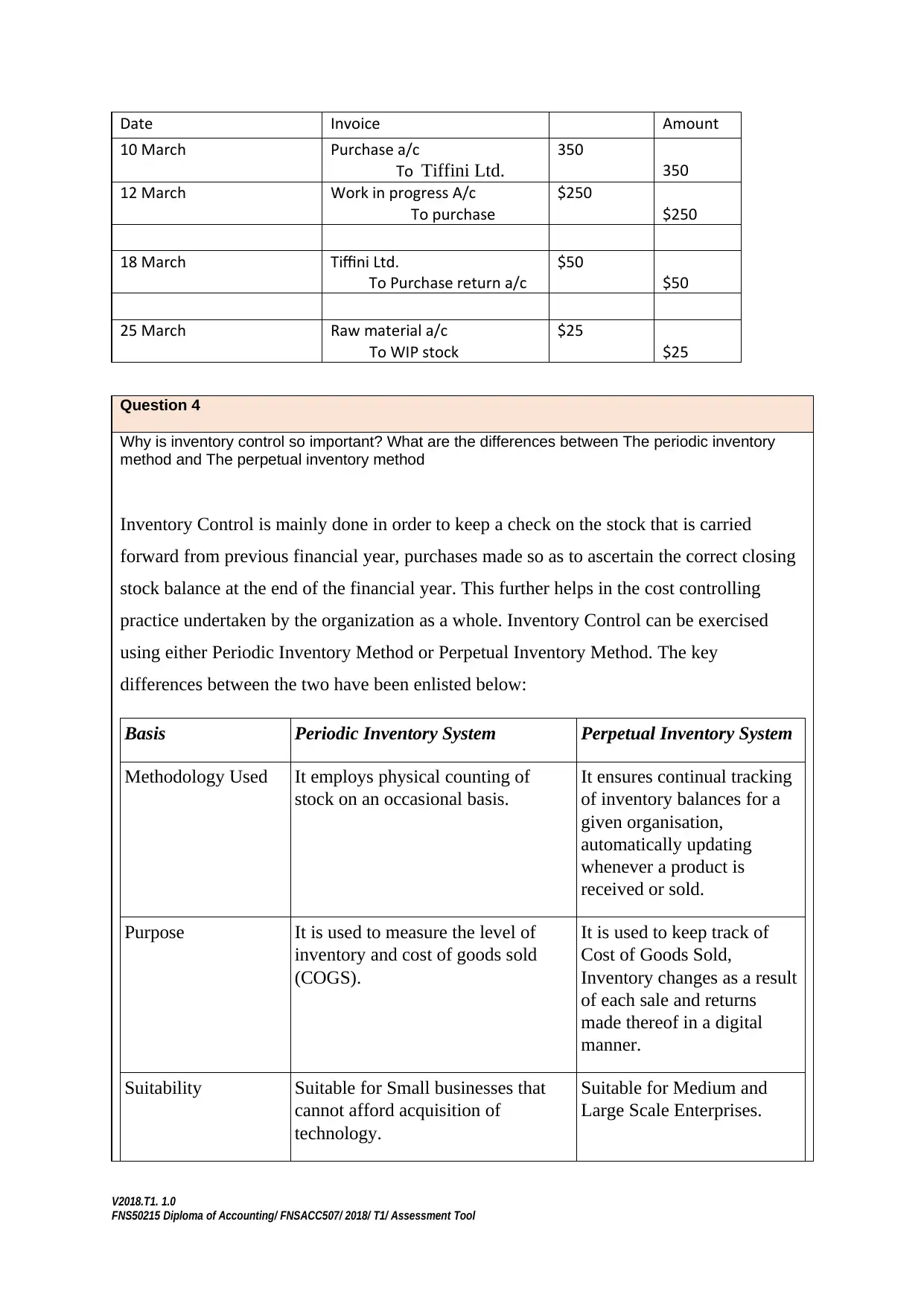
Date Invoice Amount
10 March Purchase a/c
To Tiffini Ltd.
350
350
12 March Work in progress A/c
To purchase
$250
$250
18 March Tiffini Ltd.
To Purchase return a/c
$50
$50
25 March Raw material a/c
To WIP stock
$25
$25
Question 4
Why is inventory control so important? What are the differences between The periodic inventory
method and The perpetual inventory method
Inventory Control is mainly done in order to keep a check on the stock that is carried
forward from previous financial year, purchases made so as to ascertain the correct closing
stock balance at the end of the financial year. This further helps in the cost controlling
practice undertaken by the organization as a whole. Inventory Control can be exercised
using either Periodic Inventory Method or Perpetual Inventory Method. The key
differences between the two have been enlisted below:
Basis Periodic Inventory System Perpetual Inventory System
Methodology Used It employs physical counting of
stock on an occasional basis.
It ensures continual tracking
of inventory balances for a
given organisation,
automatically updating
whenever a product is
received or sold.
Purpose It is used to measure the level of
inventory and cost of goods sold
(COGS).
It is used to keep track of
Cost of Goods Sold,
Inventory changes as a result
of each sale and returns
made thereof in a digital
manner.
Suitability Suitable for Small businesses that
cannot afford acquisition of
technology.
Suitable for Medium and
Large Scale Enterprises.
V2018.T1. 1.0
FNS50215 Diploma of Accounting/ FNSACC507/ 2018/ T1/ Assessment Tool
10 March Purchase a/c
To Tiffini Ltd.
350
350
12 March Work in progress A/c
To purchase
$250
$250
18 March Tiffini Ltd.
To Purchase return a/c
$50
$50
25 March Raw material a/c
To WIP stock
$25
$25
Question 4
Why is inventory control so important? What are the differences between The periodic inventory
method and The perpetual inventory method
Inventory Control is mainly done in order to keep a check on the stock that is carried
forward from previous financial year, purchases made so as to ascertain the correct closing
stock balance at the end of the financial year. This further helps in the cost controlling
practice undertaken by the organization as a whole. Inventory Control can be exercised
using either Periodic Inventory Method or Perpetual Inventory Method. The key
differences between the two have been enlisted below:
Basis Periodic Inventory System Perpetual Inventory System
Methodology Used It employs physical counting of
stock on an occasional basis.
It ensures continual tracking
of inventory balances for a
given organisation,
automatically updating
whenever a product is
received or sold.
Purpose It is used to measure the level of
inventory and cost of goods sold
(COGS).
It is used to keep track of
Cost of Goods Sold,
Inventory changes as a result
of each sale and returns
made thereof in a digital
manner.
Suitability Suitable for Small businesses that
cannot afford acquisition of
technology.
Suitable for Medium and
Large Scale Enterprises.
V2018.T1. 1.0
FNS50215 Diploma of Accounting/ FNSACC507/ 2018/ T1/ Assessment Tool
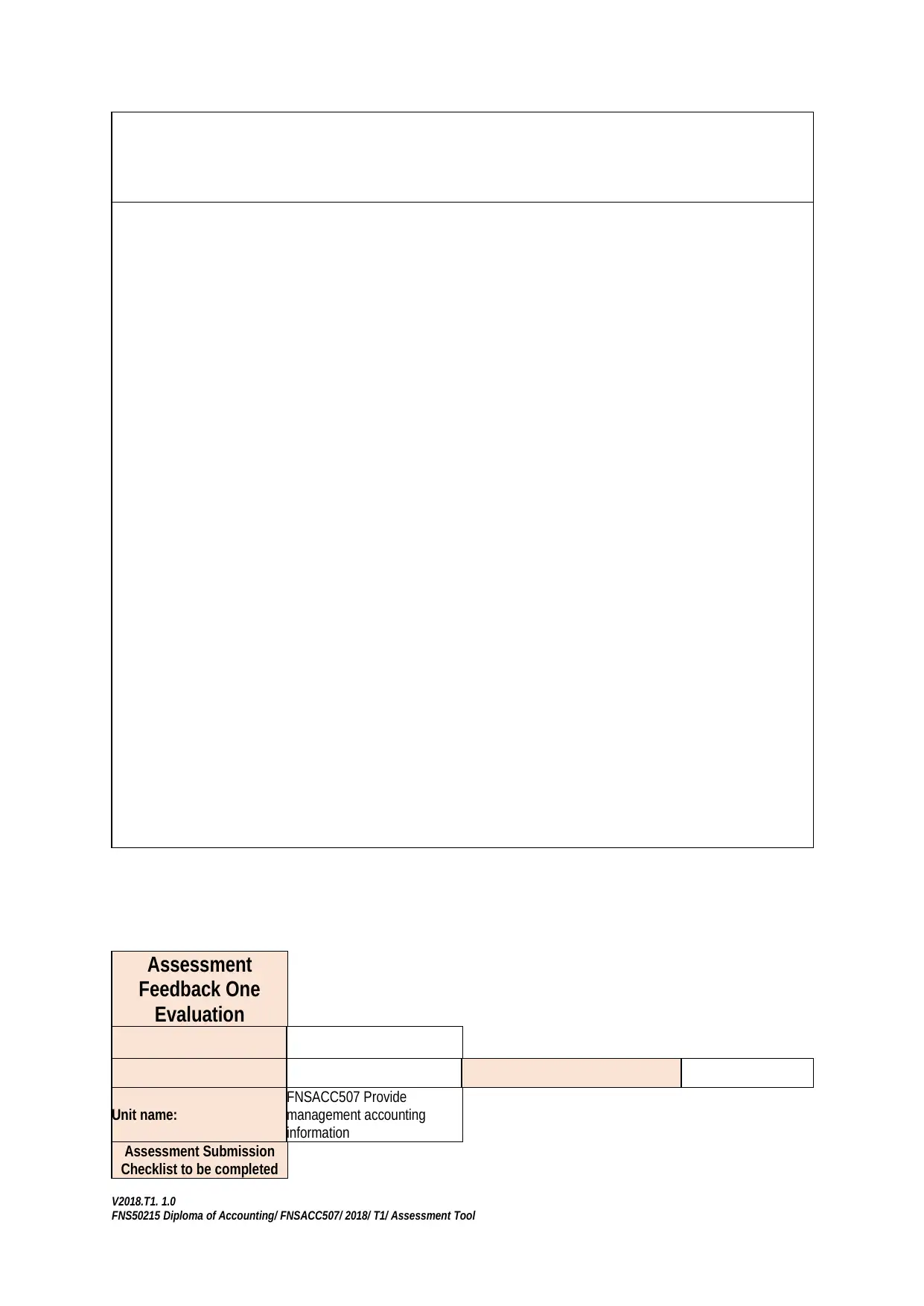
Assessment
Feedback One
Evaluation
Unit name:
FNSACC507 Provide
management accounting
information
Assessment Submission
Checklist to be completed
V2018.T1. 1.0
FNS50215 Diploma of Accounting/ FNSACC507/ 2018/ T1/ Assessment Tool
Feedback One
Evaluation
Unit name:
FNSACC507 Provide
management accounting
information
Assessment Submission
Checklist to be completed
V2018.T1. 1.0
FNS50215 Diploma of Accounting/ FNSACC507/ 2018/ T1/ Assessment Tool
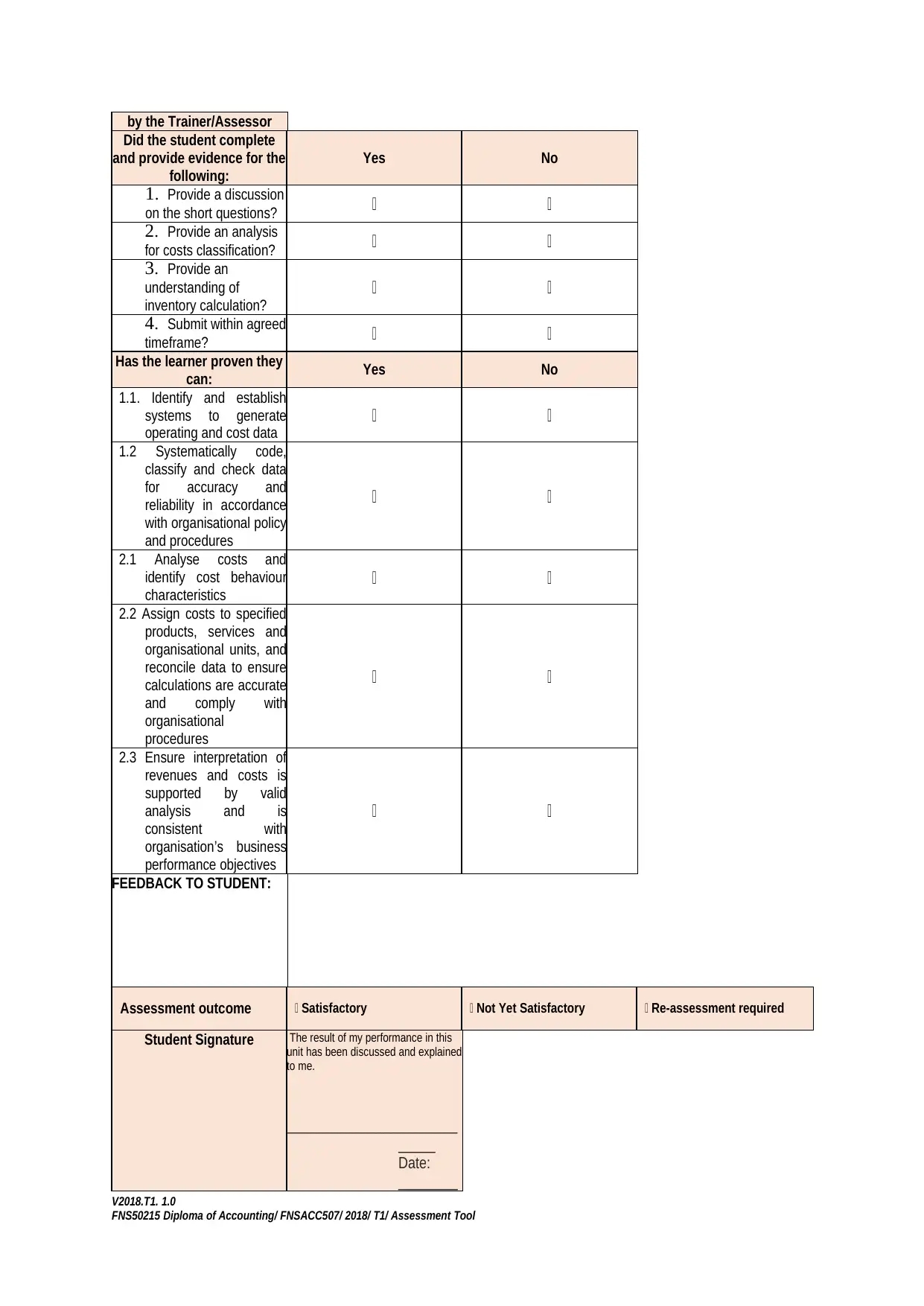
by the Trainer/Assessor
Did the student complete
and provide evidence for the
following:
Yes No
1. Provide a discussion
on the short questions?
2. Provide an analysis
for costs classification?
3. Provide an
understanding of
inventory calculation?
4. Submit within agreed
timeframe?
Has the learner proven they
can: Yes No
1.1. Identify and establish
systems to generate
operating and cost data
1.2 Systematically code,
classify and check data
for accuracy and
reliability in accordance
with organisational policy
and procedures
2.1 Analyse costs and
identify cost behaviour
characteristics
2.2 Assign costs to specified
products, services and
organisational units, and
reconcile data to ensure
calculations are accurate
and comply with
organisational
procedures
2.3 Ensure interpretation of
revenues and costs is
supported by valid
analysis and is
consistent with
organisation’s business
performance objectives
FEEDBACK TO STUDENT:
Assessment outcome Satisfactory Not Yet Satisfactory Re-assessment required
Student Signature The result of my performance in this
unit has been discussed and explained
to me.
_______________________
_____
Date:
________
V2018.T1. 1.0
FNS50215 Diploma of Accounting/ FNSACC507/ 2018/ T1/ Assessment Tool
Did the student complete
and provide evidence for the
following:
Yes No
1. Provide a discussion
on the short questions?
2. Provide an analysis
for costs classification?
3. Provide an
understanding of
inventory calculation?
4. Submit within agreed
timeframe?
Has the learner proven they
can: Yes No
1.1. Identify and establish
systems to generate
operating and cost data
1.2 Systematically code,
classify and check data
for accuracy and
reliability in accordance
with organisational policy
and procedures
2.1 Analyse costs and
identify cost behaviour
characteristics
2.2 Assign costs to specified
products, services and
organisational units, and
reconcile data to ensure
calculations are accurate
and comply with
organisational
procedures
2.3 Ensure interpretation of
revenues and costs is
supported by valid
analysis and is
consistent with
organisation’s business
performance objectives
FEEDBACK TO STUDENT:
Assessment outcome Satisfactory Not Yet Satisfactory Re-assessment required
Student Signature The result of my performance in this
unit has been discussed and explained
to me.
_______________________
_____
Date:
________
V2018.T1. 1.0
FNS50215 Diploma of Accounting/ FNSACC507/ 2018/ T1/ Assessment Tool
Paraphrase This Document
Need a fresh take? Get an instant paraphrase of this document with our AI Paraphraser
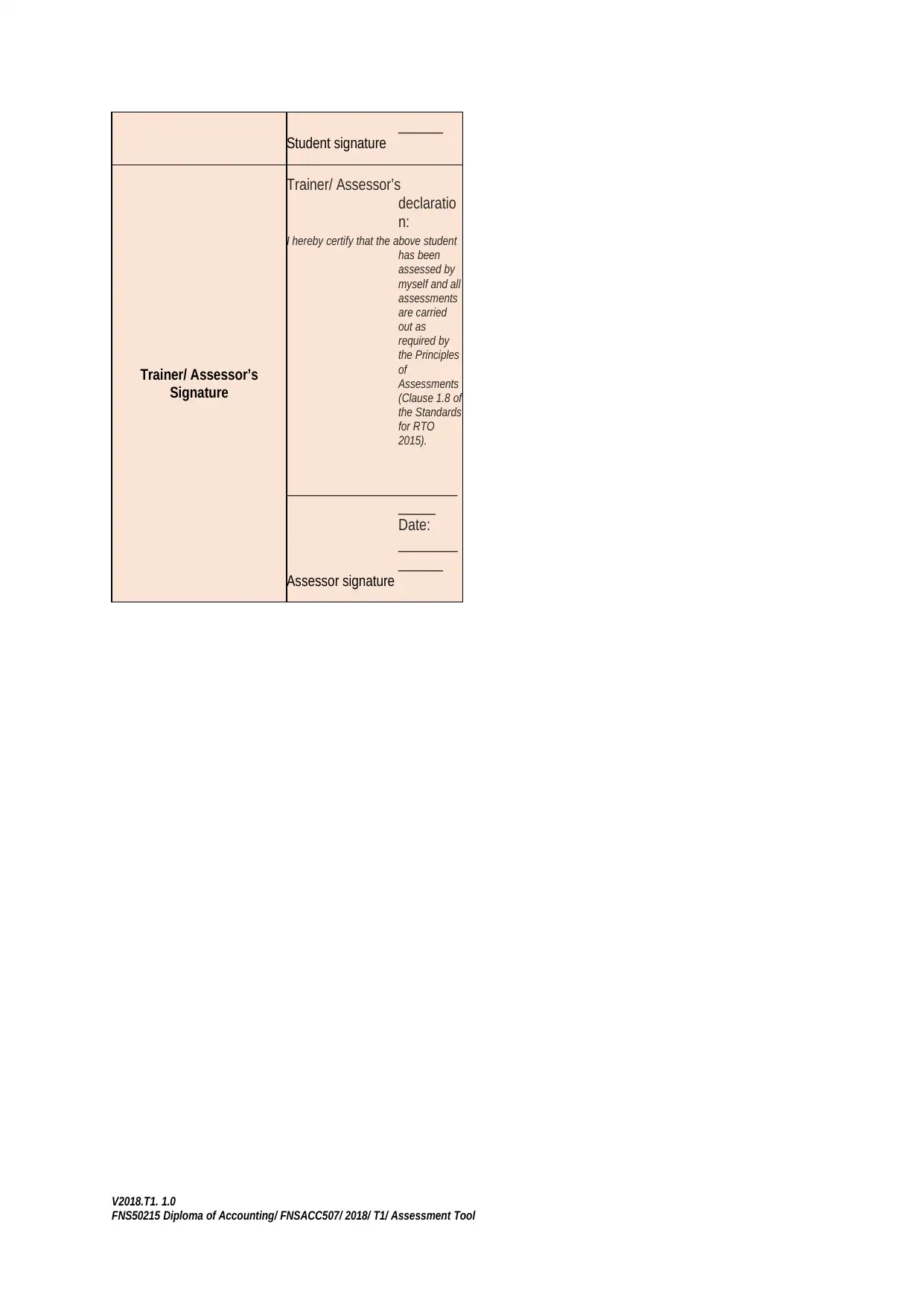
______
Student signature
Trainer/ Assessor’s
Signature
Trainer/ Assessor’s
declaratio
n:
I hereby certify that the above student
has been
assessed by
myself and all
assessments
are carried
out as
required by
the Principles
of
Assessments
(Clause 1.8 of
the Standards
for RTO
2015).
_______________________
_____
Date:
________
______
Assessor signature
V2018.T1. 1.0
FNS50215 Diploma of Accounting/ FNSACC507/ 2018/ T1/ Assessment Tool
Student signature
Trainer/ Assessor’s
Signature
Trainer/ Assessor’s
declaratio
n:
I hereby certify that the above student
has been
assessed by
myself and all
assessments
are carried
out as
required by
the Principles
of
Assessments
(Clause 1.8 of
the Standards
for RTO
2015).
_______________________
_____
Date:
________
______
Assessor signature
V2018.T1. 1.0
FNS50215 Diploma of Accounting/ FNSACC507/ 2018/ T1/ Assessment Tool
1 out of 14
Related Documents
Your All-in-One AI-Powered Toolkit for Academic Success.
+13062052269
info@desklib.com
Available 24*7 on WhatsApp / Email
![[object Object]](/_next/static/media/star-bottom.7253800d.svg)
Unlock your academic potential
© 2024 | Zucol Services PVT LTD | All rights reserved.





